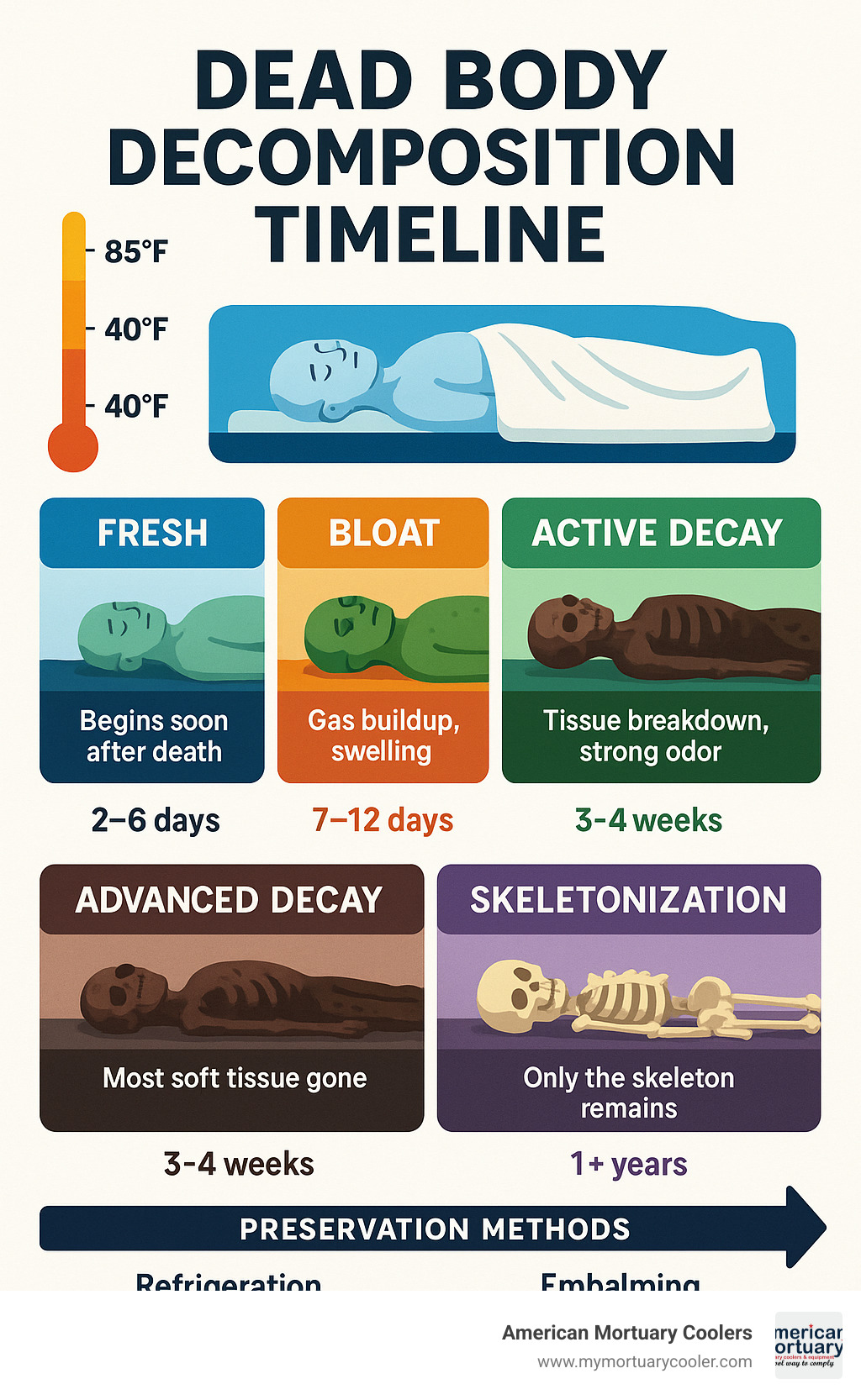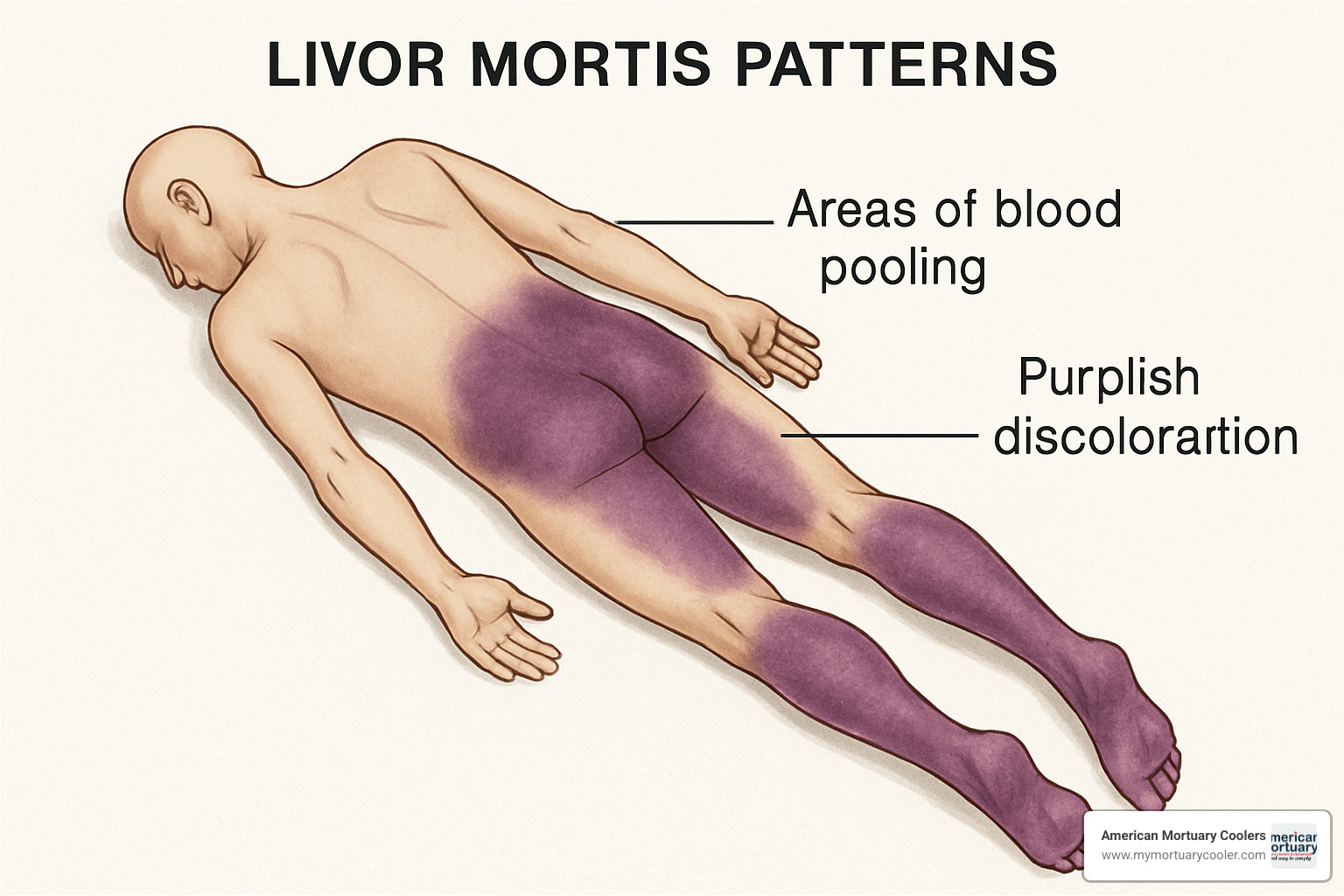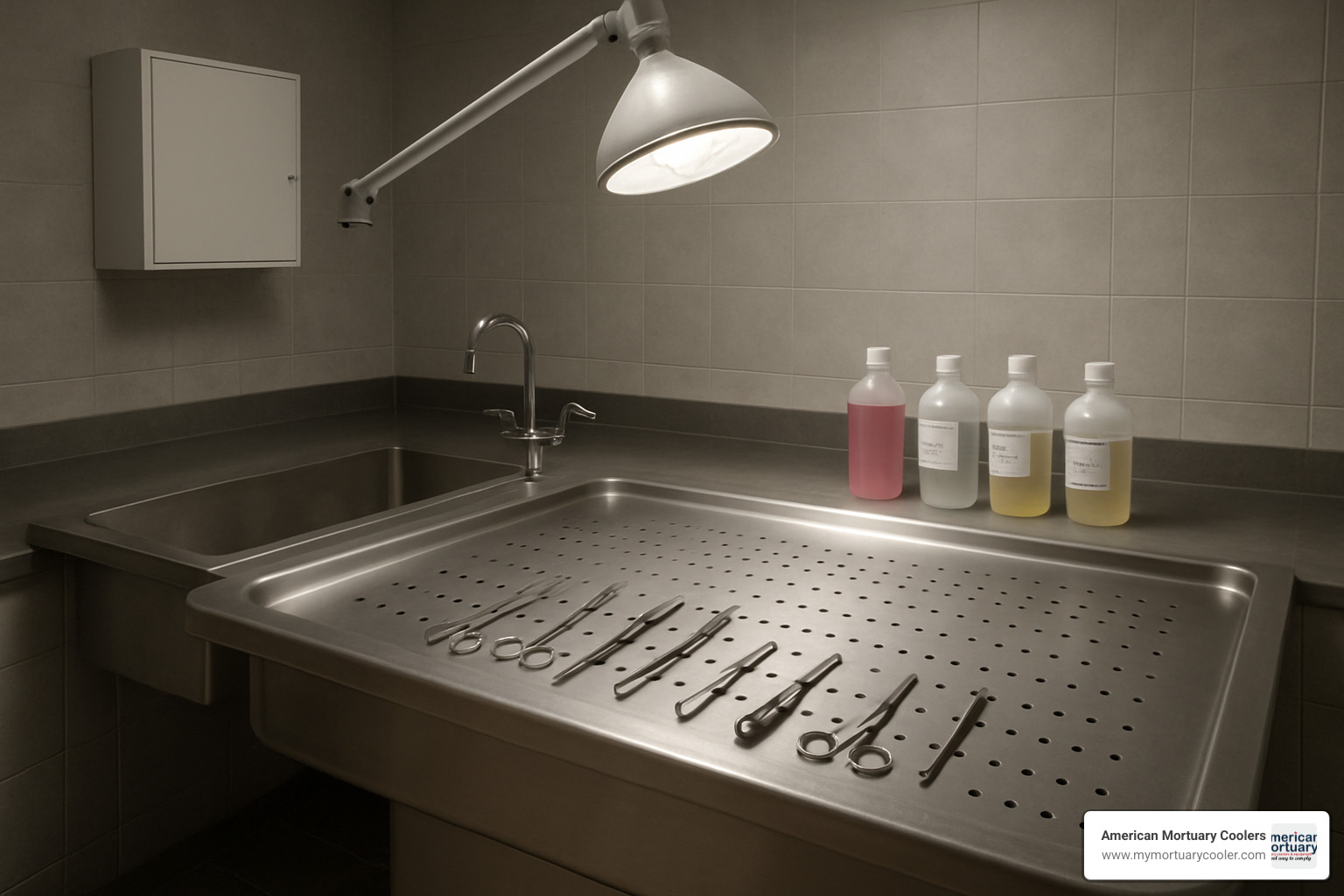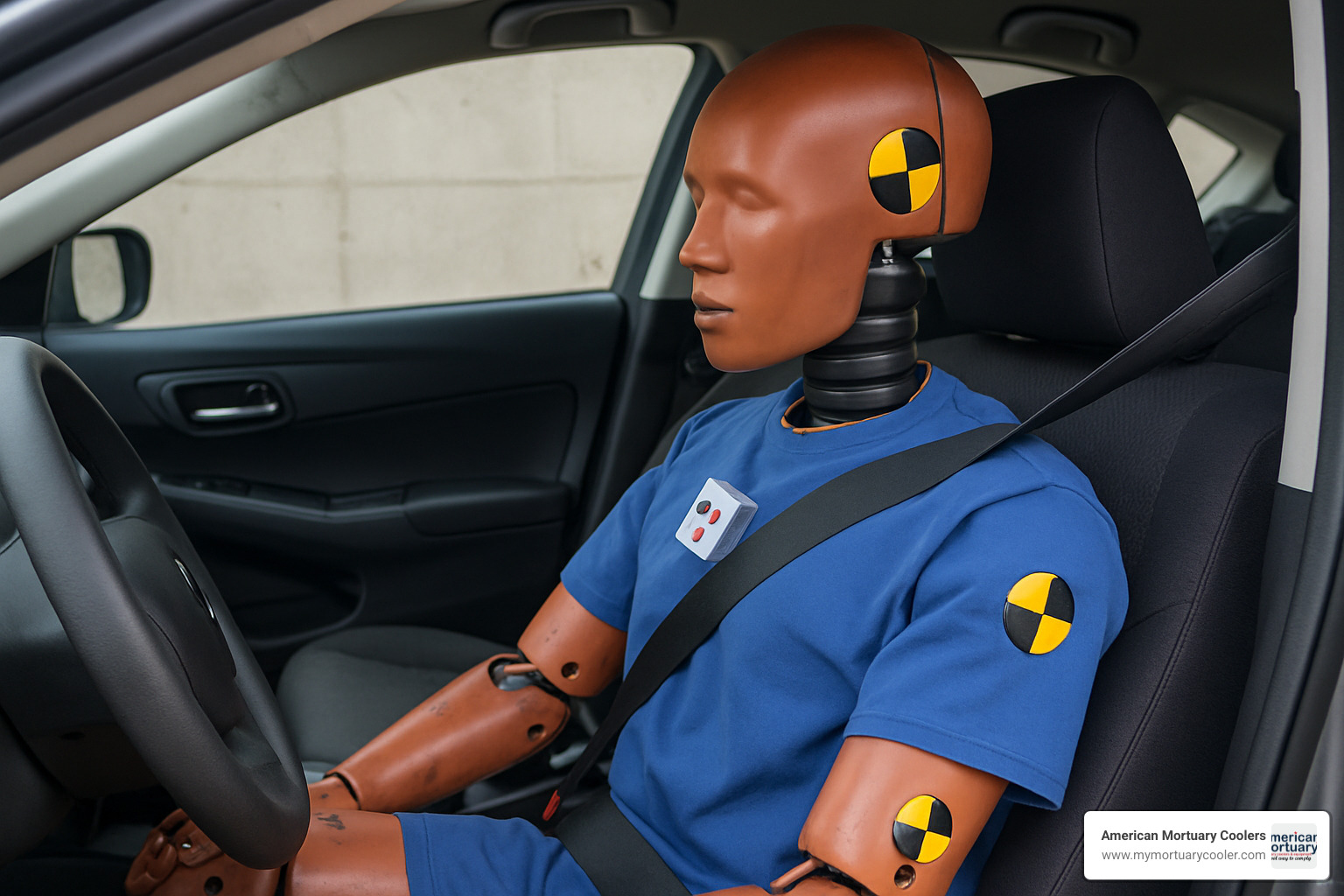Understanding Death: What Everyone Should Know About Dead Bodies
A dead body represents the physical remains of a human being after life has ended - a topic that combines scientific fascination with cultural sensitivity. Understanding what happens after death helps us make informed decisions about end-of-life care, funeral planning, and body preservation.
Quick Facts About Dead Bodies:
- Definition: A dead body is human remains after biological death occurs
- Decomposition begins: Within minutes to hours after death
- Preservation: Refrigeration at 36-39°F or embalming slows decay
- Legal status: Bodies require proper handling, storage, and disposal permits
- Uses: Medical education, forensic investigation, crash testing, and research
Death remains one of society's most uncomfortable topics, yet it affects every family. From the moment of death through final disposition, a dead body undergoes predictable changes. The first stage of decomposition, autolysis, begins within minutes to hours after death, while under normal conditions, organs become unidentifiable after just three weeks.
We're American Mortuary Coolers, a Tennessee-based company specializing in custom mortuary cooling solutions with direct delivery across the contiguous 48 states. Our experience in dead body preservation and storage solutions guides the practical insights throughout this article.

What Is a Dead Body? Terminology, Definitions & Early Post-Mortem Changes
When someone dies, their physical remains become what we call a dead body. Medical professionals use the term "cadaver," which comes from the Latin word meaning "to fall." Meanwhile, "corpse" traces back to the Latin "corpus," simply meaning body.
The fascinating thing about a dead body is how quickly changes begin. Death isn't like flipping a light switch - it's more like a series of predictable events that unfold in a specific order.
Algor mortis kicks in first - the body starts cooling down. Without a beating heart to circulate warm blood, body temperature drops about 1.5°C every hour until it matches the room temperature. This usually takes 18-20 hours.
Next comes livor mortis - the purplish discoloration you might notice on the lower parts of the body. This happens because blood, following gravity's pull, settles into the lowest areas. It starts showing up anywhere from 1 to 12 hours after death.
Finally, there's rigor mortis - the muscle stiffening that most people have heard about. It typically begins 2-6 hours after death, reaches its peak around 12 hours, then gradually fades over the next 24-84 hours.
These three changes - cooling, blood pooling, and muscle stiffening - create what forensic experts call the "forensic clock." They help determine not just when someone died, but also whether the body has been moved after death.

The Dead Body in Medical & Legal Contexts
Determining when someone has actually died isn't always straightforward. Clinical death happens when the heart stops beating and breathing ceases, but brain cells can remain active for up to 10 minutes afterward. Brain death represents the legal standard in most places - when the brain stem has irreversibly stopped functioning.
Once death is confirmed, handling a dead body becomes a matter of law. Death certificates must be completed by qualified medical professionals. The legal framework for using bodies in medical education traces back to the Anatomy Act of 1832, which established proper procedures for using unclaimed bodies for teaching purposes.
The Dead Body and Language Across Cultures
The words we choose when talking about a dead body reveal cultural attitudes toward death. In English, we often reach for gentler terms like "remains," "departed," or "deceased" - anything to soften the harsh reality of mortality. Different cultures approach this differently, with some accepting direct terminology while others develop elaborate euphemisms.
According to scientific research on cadaver definition, the medical community has worked to standardize terminology to improve communication between professionals while remaining respectful to families and cultural sensitivities.
From Fresh to Skeleton: Stages of Human Decomposition
The journey from a fresh dead body to skeletal remains follows nature's most predictable timeline. Understanding decomposition helps families make informed decisions about burial timing, preservation methods, and funeral planning.
When death occurs, the body transforms through five distinct stages:
The fresh stage spans the first three days after death. During this period, autolysis begins as cells break down from oxygen deprivation. The body releases approximately 30 different chemical compounds, creating the characteristic smell of death.
Bloat stage arrives between days four and ten. Bacteria in the digestive system produce gases that can double the body's size. The skin shifts from its natural color to green, then progresses to black.
Active decay dominates days ten through twenty-five. Soft tissues begin liquefying, and the body loses significant mass. This stage attracts insects, particularly blowflies that lay eggs in body cavities. The maggot activity during this phase helps forensic investigators determine time of death.

Advanced decay continues from day twenty-five to fifty. The remaining soft tissues dry out, exposing hair, nails, and bones. By this point, the body bears little resemblance to its living form.
Skeletonization begins around day fifty but can take months or years to complete. Only bones, hair, and cartilage survive this final stage.

Dead Body Timeline: Hours to Days
The first 72 hours represent the most critical window for preservation decisions. Cellular breakdown begins within minutes, making this period crucial for families considering viewing options.
Hour zero to one marks the beginning of temperature drop. Hours one through three bring the onset of rigor mortis in facial muscles. Hours six through twelve see rigor mortis spreading throughout the entire body. Hours twelve through twenty-four mark when livor mortis becomes permanently fixed. Hours twenty-four through seventy-two witness the beginning of internal organ decomposition.
How Environment Speeds or Slows a Dead Body's Decay
Temperature acts as decomposition's primary accelerator. At 100°F, a body decomposes twice as fast as at 50°F. Moisture levels create surprising preservation effects - high humidity actually slows decomposition by limiting oxygen availability to bacteria. Oxygen availability determines bacterial activity levels, while soil chemistry affects preservation in unexpected ways.
These environmental factors explain why mortuary coolers maintain consistent temperatures and humidity levels.
Preserving the Dead Body: From Embalming to Plastination
When someone dies, families often need time to arrange services or complete legal requirements. That's where body preservation comes in - giving us the breathing room we need during an already difficult time.
The most common preservation method is embalming, where funeral directors replace the body's blood with formaldehyde-based chemicals through arterial injection. This process can keep a dead body looking natural for weeks or even months. However, embalming isn't legally required in most places.
Refrigeration offers a simpler, more flexible approach. By keeping a dead body at temperatures between 36-39°F, bacterial growth slows dramatically without any chemical treatments.

Modern Refrigeration & Morgue Coolers
Professional body storage requires specialized equipment. Walk-in mortuary coolers provide space and temperature control for multiple bodies, while smaller body boxes work well when space is limited.
At American Mortuary Coolers, we've been designing custom refrigeration solutions for funeral homes, hospitals, and morgues across Tennessee, Georgia, Illinois, South Carolina, Texas, California, New York, and Pennsylvania. Our units maintain that critical 36-39°F temperature range while treating every dead body with dignity.
Professional mortuary coolers need body lifts for safe handling, high-R-value insulation to keep energy costs down, and adjustable shelving to accommodate bodies of different sizes.
Chemical Preservation & Scientific Displays
Beyond funeral services, scientific preservation serves education and research. Plastination revolutionized medical education by replacing body fluids with plastics, creating specimens that last indefinitely. Arterial injection with specialized fluids maintains tissue color and structure for medical schools.
Historical and Cultural Mummification
Humans have been trying to preserve the dead for thousands of years. Ancient Egyptians spent 4,000 years perfecting their mummification techniques. Today's cryonics facilities represent our modern attempt at defeating death, preserving bodies in liquid nitrogen hoping future technology might reverse the dying process.
What Happens to a Dead Body Around the World: Disposal, Law & Ritual
When someone dies, what happens to their dead body depends largely on where they lived and what they believed. Around the world, families honor their deceased through practices that range from ancient traditions to cutting-edge green technology.
Ground burial remains the most familiar choice, with bodies typically placed in caskets about six feet underground. Cremation offers another widely accepted option - in Japan, nearly 99% of families choose cremation.
Some cultures accept more unusual approaches. Sky burial in Tibet involves placing the dead body on mountaintops where vultures can consume the remains. Sea burial requires special permits and must happen in designated deep-water areas.
Eco-Friendly Futures: Human Composting & Dissolution
Environmental concerns are reshaping how we think about dead body disposal. Human composting, officially called natural organic reduction, has gained legal approval in Washington, Colorado, Vermont, Oregon, California, and New York. This process transforms a dead body into nutrient-rich soil conditioner within 30 to 60 days.
Alkaline hydrolysis uses lye solutions to gently dissolve soft tissues while leaving bones intact. This method produces only one-tenth the carbon emissions of traditional cremation while using less energy.
Body Donation & Dissection Laws
Medical schools depend on donated bodies to train the next generation of doctors. Approximately 28,000 appendectomies are practiced on human cadavers each year in the United States alone. The Anatomy Act of 1832 ended the grisly era of grave robbing by providing medical schools legal access to unclaimed bodies.
At American Mortuary Coolers, we understand that donated bodies require the same careful preservation as those destined for traditional burial. Our professional guide to safely handling bodies helps ensure donated remains receive dignified treatment.
Dead Bodies in Science, Safety Testing, Forensics & Art
The study of dead bodies extends far beyond funeral homes and morgues. For centuries, human remains have quietly contributed to scientific breakthroughs that save lives every day.
Medical schools still consider cadaver dissection the gold standard for anatomy education. Students learn how organs feel, how tissues connect, and how individual bodies vary - knowledge that's impossible to gain from computer screens.
The automotive industry owes much of its safety progress to cadaver research. From the 1930s through the 1990s, researchers used human bodies to understand how crashes affect the human frame. The data collected from these studies has prevented an estimated 143,000 injuries and 4,250 deaths annually.
Body farms represent one of forensic science's most valuable tools. These research facilities study decomposition under controlled conditions, helping investigators solve crimes by accurately estimating time since death.

The Dead Body in Criminal Investigations
When investigators find a dead body at a crime scene, decomposition patterns tell a story. Forensic entomology - the study of insects on corpses - provides crucial timeline evidence. Different bugs arrive at predictable intervals, creating a biological clock that helps establish when death occurred.
Saving Lives: Cadavers in Medical Education & Car Safety
Medical innovation depends heavily on cadaver research. Surgeons practice approximately 28,000 appendectomies on human bodies annually in the United States alone. The crash test data revealed that human skulls can withstand up to 1.5 tons of pressure for one second before fracturing, directly influencing helmet design and vehicle safety systems.
Depicting the Dead Body in Art & Media
Leonardo da Vinci performed illegal dissections to perfect his anatomical drawings, advancing both artistic technique and medical knowledge. Contemporary art installations featuring preserved human bodies continue this tradition of using dead bodies for education while raising important questions about consent and dignity.
Psychological, Ethical, and Social Dimensions of Confronting a Dead Body
The human response to encountering a dead body varies dramatically from person to person. Some people feel overwhelming grief, while others experience curiosity or even relief. These reactions are completely normal - death touches something deep in our psychology.
For most of us, seeing a decomposing body triggers immediate physical responses. The smell alone can cause nausea within minutes, and our brains are hardwired to associate decay with danger. Family members viewing their loved one's remains often struggle with conflicting emotions - wanting to say goodbye while feeling disturbed by physical changes.
Working With a Dead Body: Impact on Professionals
People who work with dead bodies every day develop remarkable coping skills. Pathologists, embalmers, and morgue technicians learn to maintain professional detachment while still treating each person with dignity.
Compassion fatigue affects many death-care professionals. The best funeral homes and medical facilities now provide mental health support and peer counseling programs to help their staff process these experiences.
Public Myths About the Contagious Dead Body
One of the most persistent myths about dead bodies is that they spread disease after disasters. The World Health Organization has repeatedly confirmed that bodies pose minimal disease risk when handled with basic precautions.
This myth becomes dangerous during natural disasters when authorities rush to dispose of bodies to "prevent epidemics." The reality is that living people spread disease far more effectively than the deceased. Understanding these facts helps communities respond more appropriately to disasters while respecting both public health and human dignity.
Frequently Asked Questions about Dead Bodies
People naturally have questions about what happens to a dead body after death. These concerns often arise during difficult times when families need clear, honest answers to make informed decisions. Let's address the most common questions we hear at American Mortuary Coolers.
How quickly does a dead body start to decompose?
The decomposition process begins surprisingly quickly after death occurs. Cellular autolysis starts breaking down tissues from the inside within just minutes of death, as cells can no longer maintain themselves without oxygen and nutrients.
You won't see visible changes immediately, though. The first noticeable signs typically appear within 24 to 72 hours. During this time, the body temperature drops to match the surrounding environment, rigor mortis causes muscle stiffening, and blood begins pooling in lower areas of the body.
This rapid timeline explains why funeral homes and morgues use refrigeration to slow decomposition. Our mortuary coolers maintain temperatures between 36-39°F, which significantly extends the time families have to make arrangements and hold services.
Can a dead body spread disease after a natural disaster?
This question comes up frequently after hurricanes, earthquakes, or other disasters, but the answer might surprise you. Dead bodies from natural disasters generally do not cause disease epidemics.
The World Health Organization has studied this extensively and confirms that properly handled corpses pose minimal disease risk to the public. The diseases that killed people during the disaster don't magically become more contagious after death.
Recovery workers should still use basic precautions like gloves, masks, and proper hygiene when handling bodies. These simple measures provide adequate protection while allowing dignified recovery and identification of the deceased.
The myth about contagious corpses unfortunately leads to hasty mass burials that prevent proper identification and deny families closure. Understanding the real risks helps communities respond more appropriately during tragic circumstances.
What's the most eco-friendly way to dispose of a dead body?
Environmental consciousness increasingly influences end-of-life decisions. Human composting, also called natural organic reduction, currently offers the most environmentally friendly option available.
This process converts a dead body into nutrient-rich soil conditioner within 30 to 60 days using controlled microbial activity. The method is legal in Washington, Colorado, Vermont, Oregon, California, and New York, with more states considering legislation.
Alkaline hydrolysis provides another eco-friendly alternative, producing 90% fewer emissions than traditional cremation. This process uses lye solutions to dissolve soft tissues, leaving only bones and sterile liquid.
For families preferring burial, natural burial without embalming reduces environmental impact compared to conventional burial. Bodies are placed in biodegradable caskets or shrouds, allowing natural decomposition while avoiding chemical preservation.
Traditional cremation and burial remain valid choices, but these newer options address growing concerns about cemetery land use and carbon emissions while providing meaningful alternatives for environmentally conscious families.
Conclusion
Death touches every family, yet it remains one of our most misunderstood topics. By understanding what happens to a dead body after death - from those first cellular changes through final disposition - we can make better choices during life's most difficult moments.
The journey from death to final rest involves remarkable biological processes. Modern preservation methods give us options our ancestors never had. Refrigeration at 36-39°F can maintain a body for weeks without chemicals. Embalming allows time for distant relatives to gather. Even newer methods like human composting offer environmentally conscious alternatives.
At American Mortuary Coolers, we've seen how proper preservation equipment supports families during grief. Our custom mortuary coolers provide dignified storage while giving funeral directors the tools they need to serve their communities.
The cultural and legal aspects matter just as much as the science. From sky burial in Tibet to natural burial meadows in America, every culture has developed meaningful ways to care for the dead. Understanding these practices helps us respect diverse traditions while following local laws and health requirements.
Perhaps most importantly, talking openly about death reduces fear and misinformation. When families understand their options - from traditional burial to eco-friendly composting - they can make choices that reflect their values and provide comfort during loss.
The dead body represents more than biological remains. It's a bridge between life and memory, science and spirituality, individual loss and universal human experience. By approaching this topic with both scientific accuracy and cultural sensitivity, we honor the deceased while serving the living.
For more information about professional mortuary cooling solutions, visit our comprehensive guide to mortuary cold storage options.
Terms related to dead body:


















